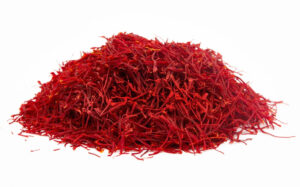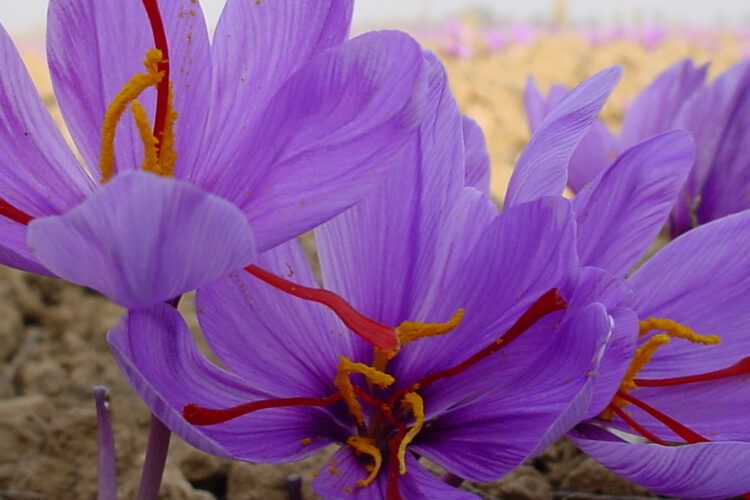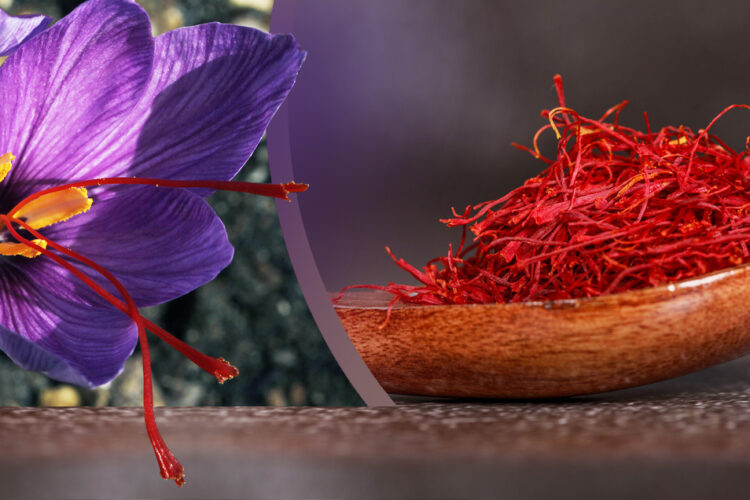Saffron is the most expensive spice in the world with extraordinary properties. Saffron is one of the spice and medicinal plants in the world that is cultivated in Iran, Egypt, Spain, Italy, Turkey, Switzerland, Pakistan and Morocco. It is one of the most important sources of non-oil exports in our country and every year more than 75% of saffron produced in the country is exported outside of Iran, including the UAE, India and Europe.
 It is a perennial plant that grows up to 30 cm in height. This plant has purple flowers with six petals. Saffron flowers have three flags and a female leading to the three-branched stigma in red. The part used in this plant is the end of the cream and the three-branched stigma, which is known as saffron and has a fragrant color and smell. It is a plant that is rich in value. It is called red gold and is the main income of the people in the cities of Khorasan.
It is a perennial plant that grows up to 30 cm in height. This plant has purple flowers with six petals. Saffron flowers have three flags and a female leading to the three-branched stigma in red. The part used in this plant is the end of the cream and the three-branched stigma, which is known as saffron and has a fragrant color and smell. It is a plant that is rich in value. It is called red gold and is the main income of the people in the cities of Khorasan.
Saffron has onions. This onion has brown shells. This plant grows in southwestern Asia, southern Spain and southern Europe. Propagation of saffron is common exclusively by the underground tuber of coriander or cormorant onion.
It has a stem and six purple petals and usually 3 strands (there are more than three strands sometimes) red stigma called saffron root. The part used by the saffron plant is its orange stigma, the color of its flowers. Zarparan stigma contains fat, minerals and mucilage.
History of saffron
Crocus Sativus, commonly known as saffron, is one of the most expensive spices in the world, and has been used by humans for centuries. Egyptian healers used it to treat gastrointestinal diseases; Also in ancient Rome, this plant was used to heal wounds and relieve upper respiratory problems.
Today, it is used as an anti-inflammatory and anti-cancer agent, and its effectiveness in treating cognitive deficits has been studied. Other uses of saffron in traditional medicine include abortion as well as treatment of spasms, fever, colds, bronchitis and insomnia.
In traditional and Ayurvedic medicine, saffron is used as an expectorant, sedative, anti-asthma, adaptogen, or regularizer (medicine or anything to speed up or intensify menstrual bleeding). It is used during the 16th to 19th centuries to prepare various medicinal compounds to relieve pain.
This extraordinary spice is native to southern Europe and is cultivated today in many countries, mainly Italy, France, Spain, Iran, Greece, Turkey, and Kashmir and Jammu in India. Dried stigma is very important in the production of cosmetics, pharmaceuticals and dyes for textiles and textiles, as well as in cooking.
Although the plant is difficult to grow in Sweden, the authors have stated at Swedish festivals that it is an amazing spice that has long been added to St. Lucia's special breads. Many cultures have accepted the use of Zarparan as a medicinal or food substance, although most people can rarely use it due to its high humidity.
The ancient Greeks described the vast wealth of their gods by describing a throne of saffron to Zeus.
Another name for saffron
In ancient times it was called "Blood of Hercules" and was used as a protective spell and for incense. The saffron cake was baked by the Phoenicians in honor of the goddess of fertility, the moon and the moon. In ancient times, it was called Zarparan.
In the Mediterranean region, this spice was associated with strength, fertility, psychic allergies and sexual potency. Adding goldsmiths to love potions and juices has been a popular ritual and cultivation for them.
In the Old Testament, in the lyric section of Suleiman, along with Hejazi, aloe, calamus and cinnamon, this plant is mentioned as one of the most valuable and best spices. This plant was picked only by women who had a high social status, such as nuns, who wore clothes dyed with saffron.
The Egyptians mixed saffron with honey, and the Romans wanted this plant because it was considered a stimulant of sexual instinct and they sprayed it on their wedding bed on the night of their marriage.
Throughout its history, this plant has been used in body wash compounds as a sedative, in dried leaf containers, in cosmetics, as an antidepressant, and of course - to color and flavor traditional foods.

Saffron from planting to harvest
The history of saffron cultivation in Iran dates back to ancient times. Then it was taken from Iran to Greece...

What are the properties of saffron?
In ancient medicine, the new Venice of this plant is called as a pharmacy due to its many medicinal and...






